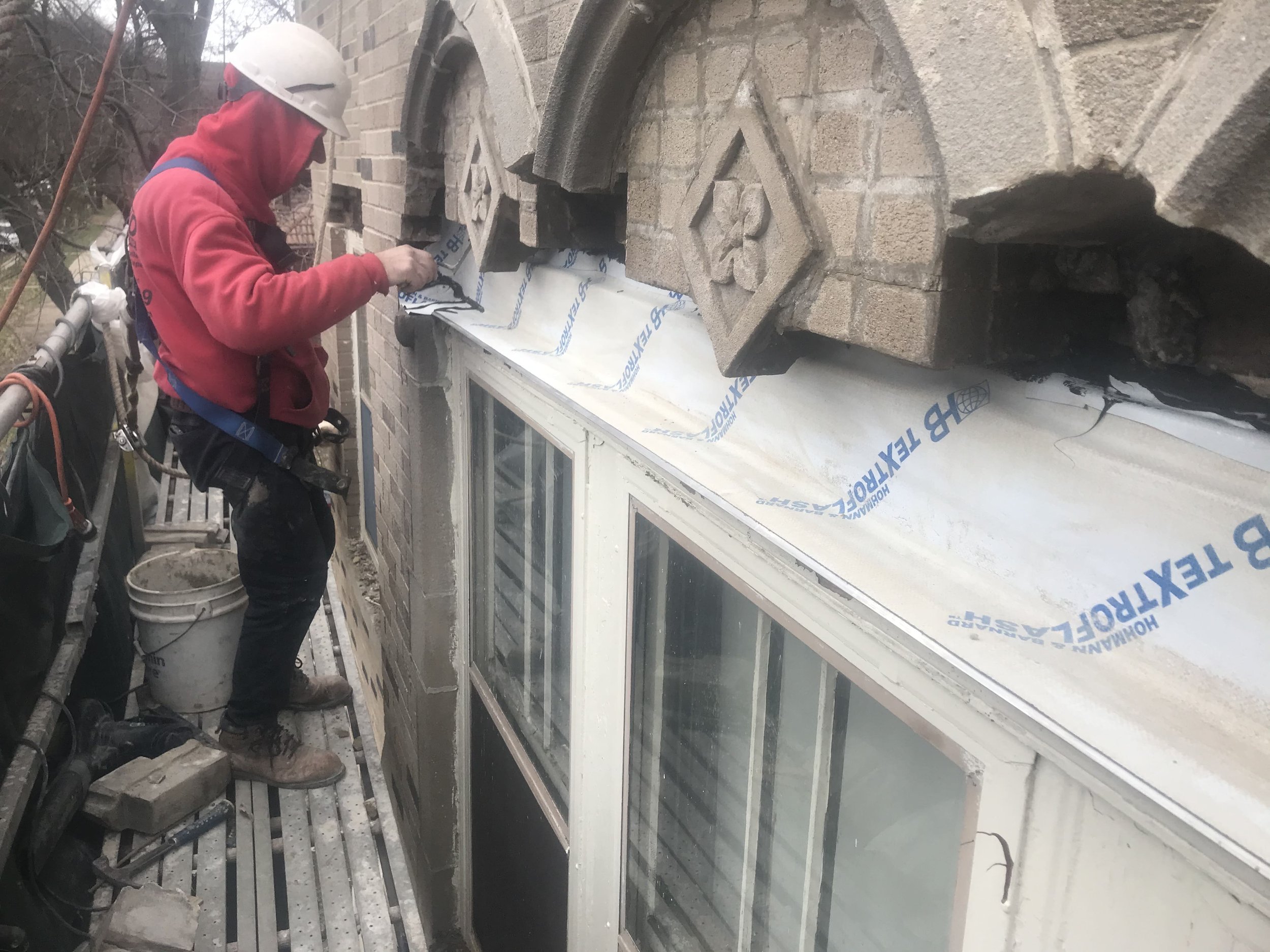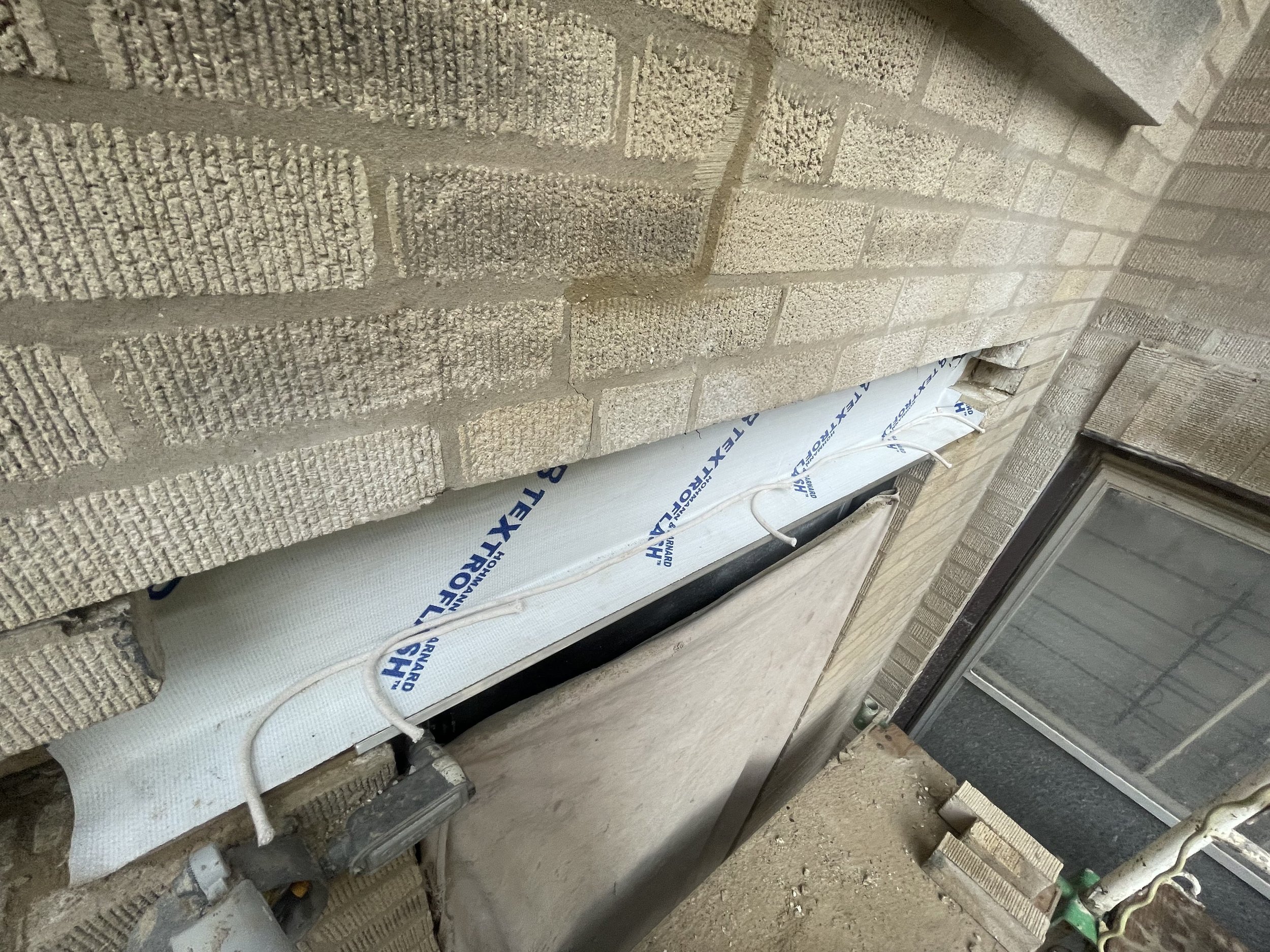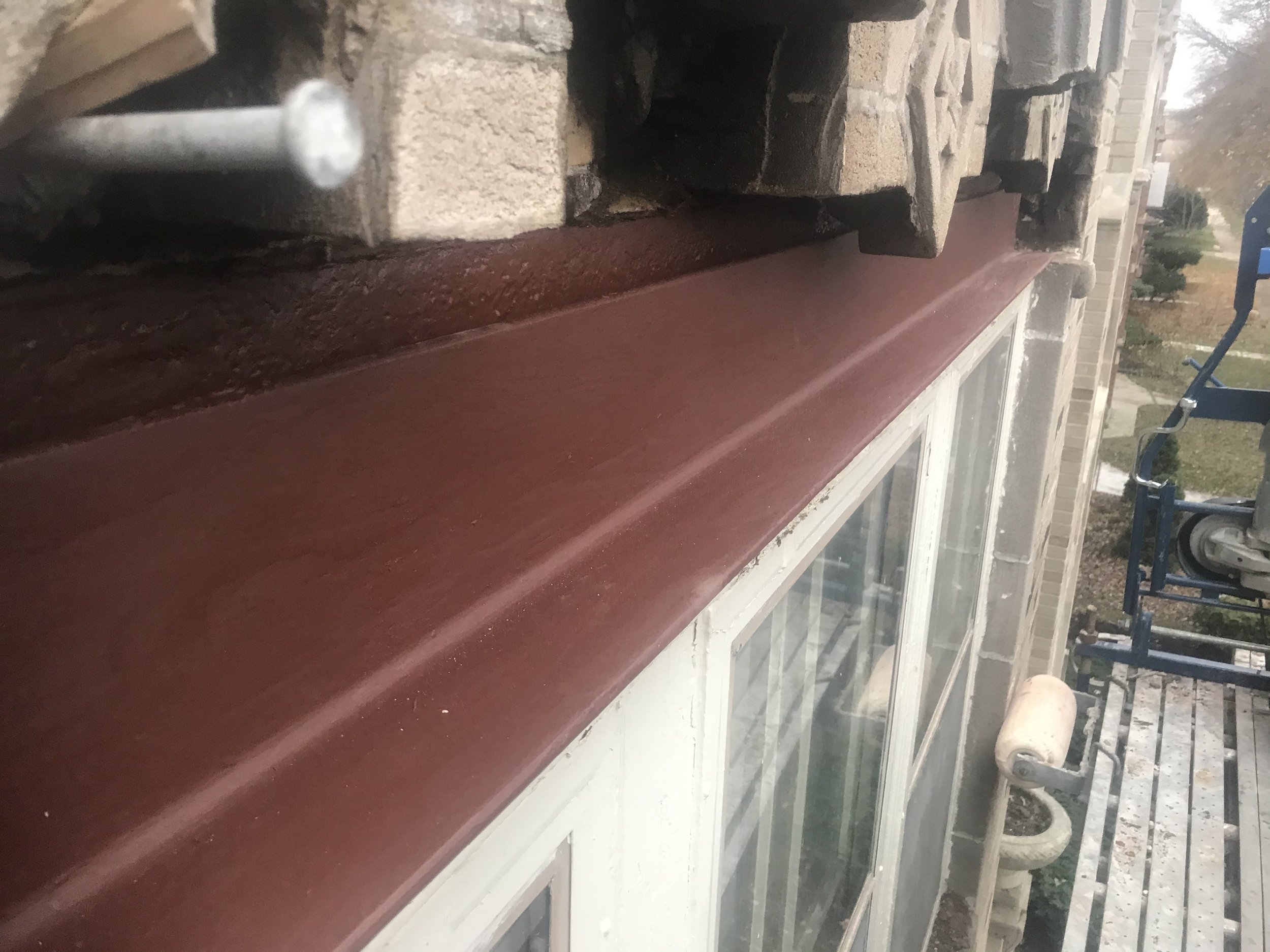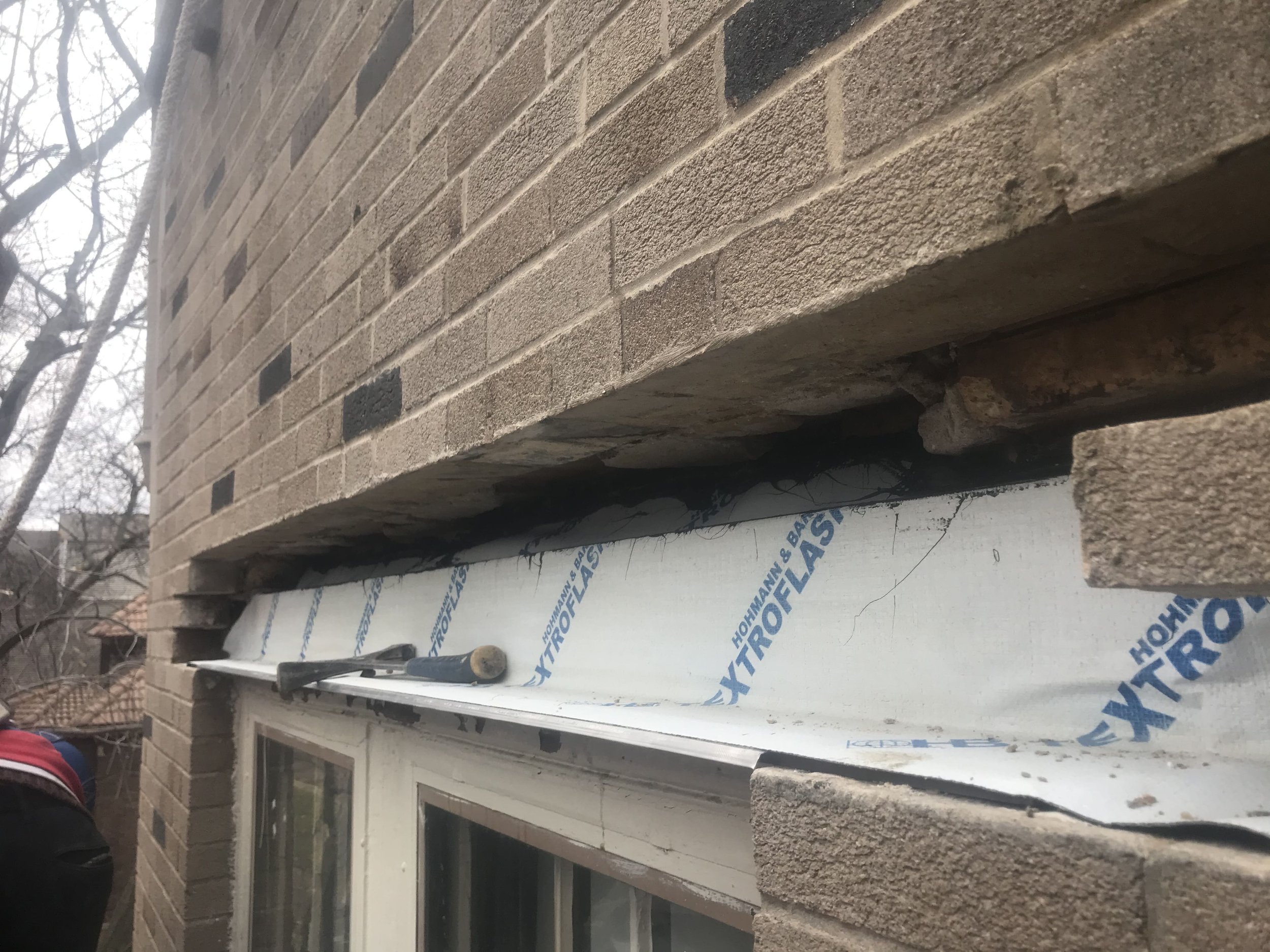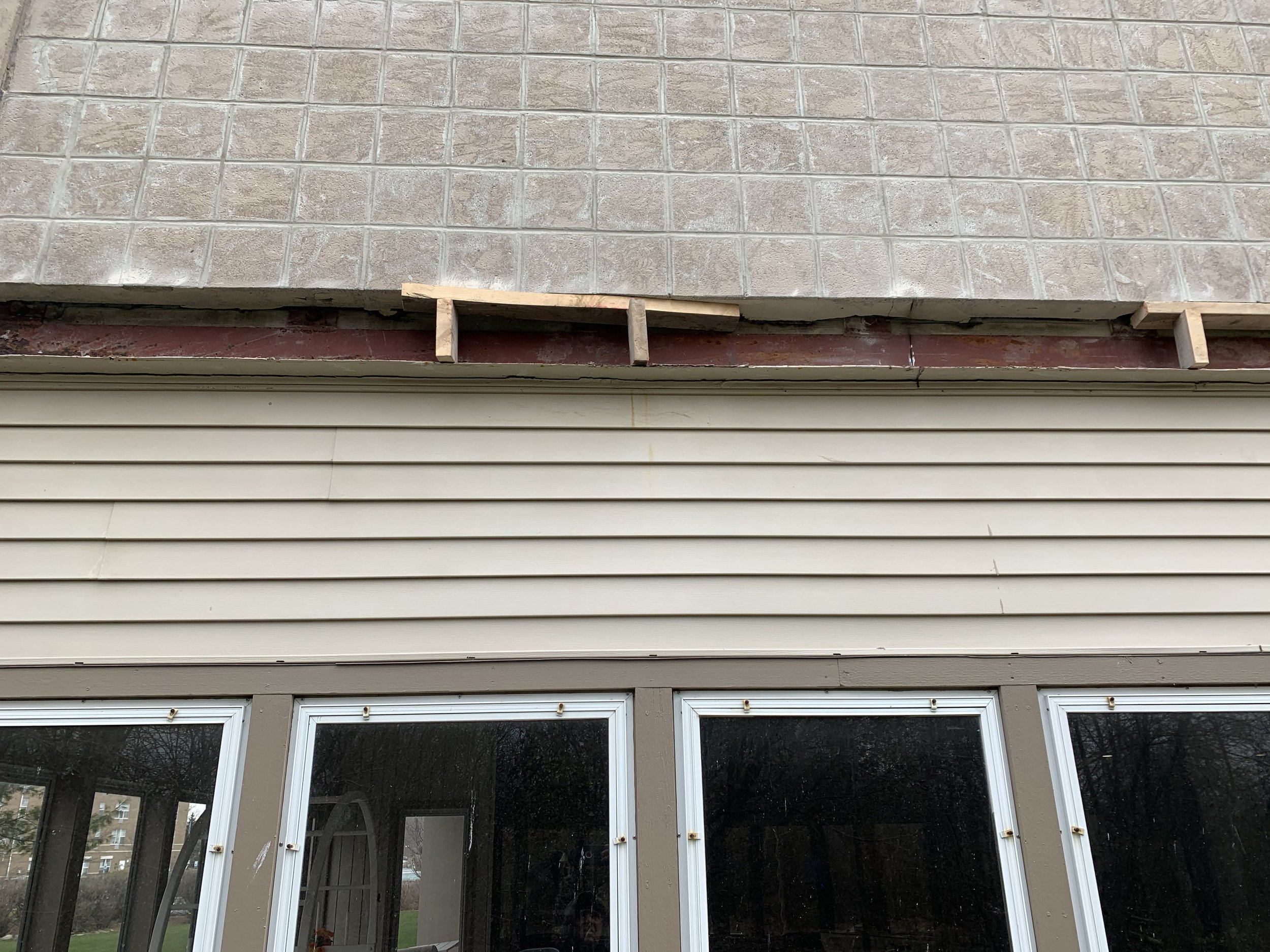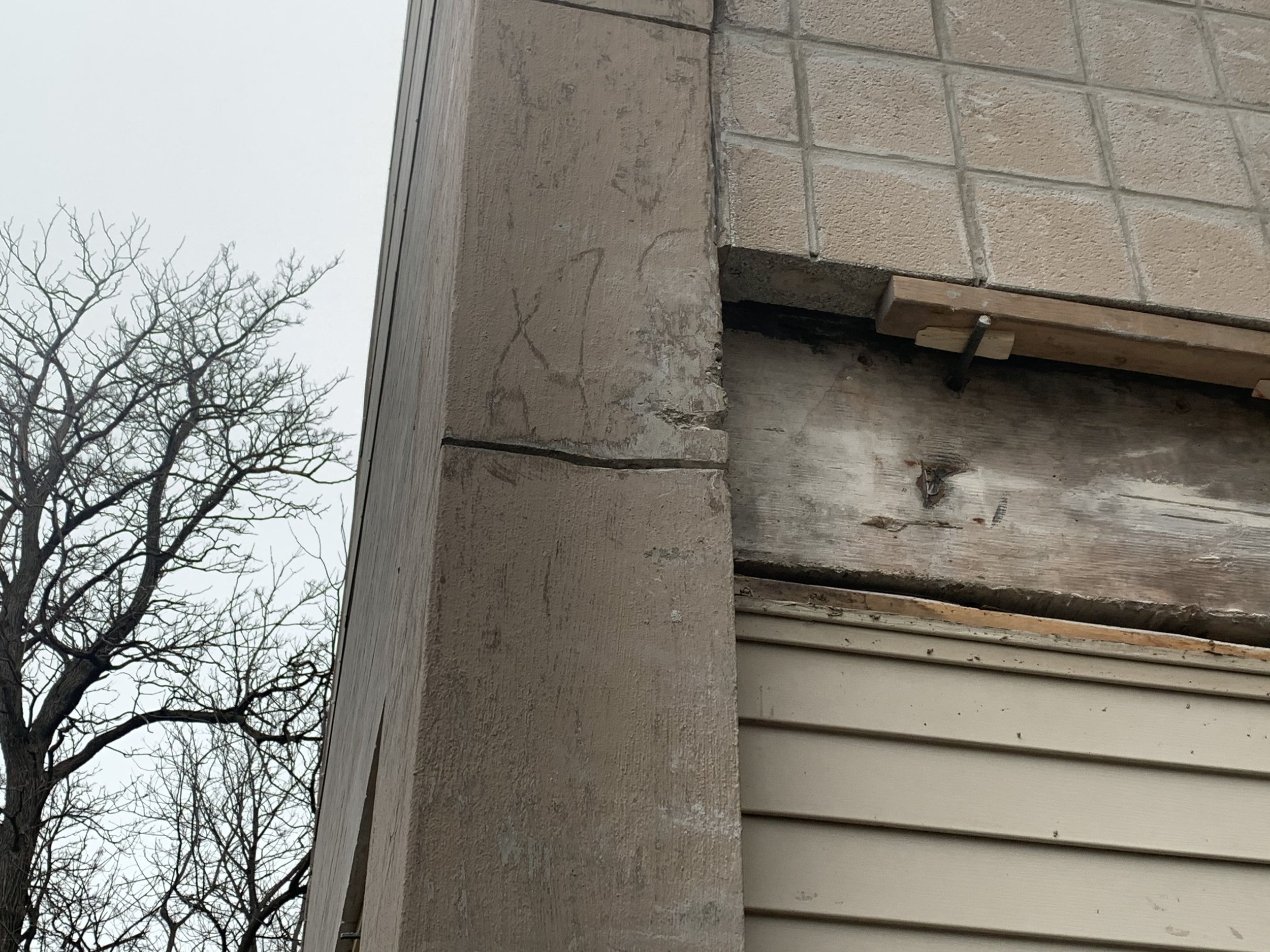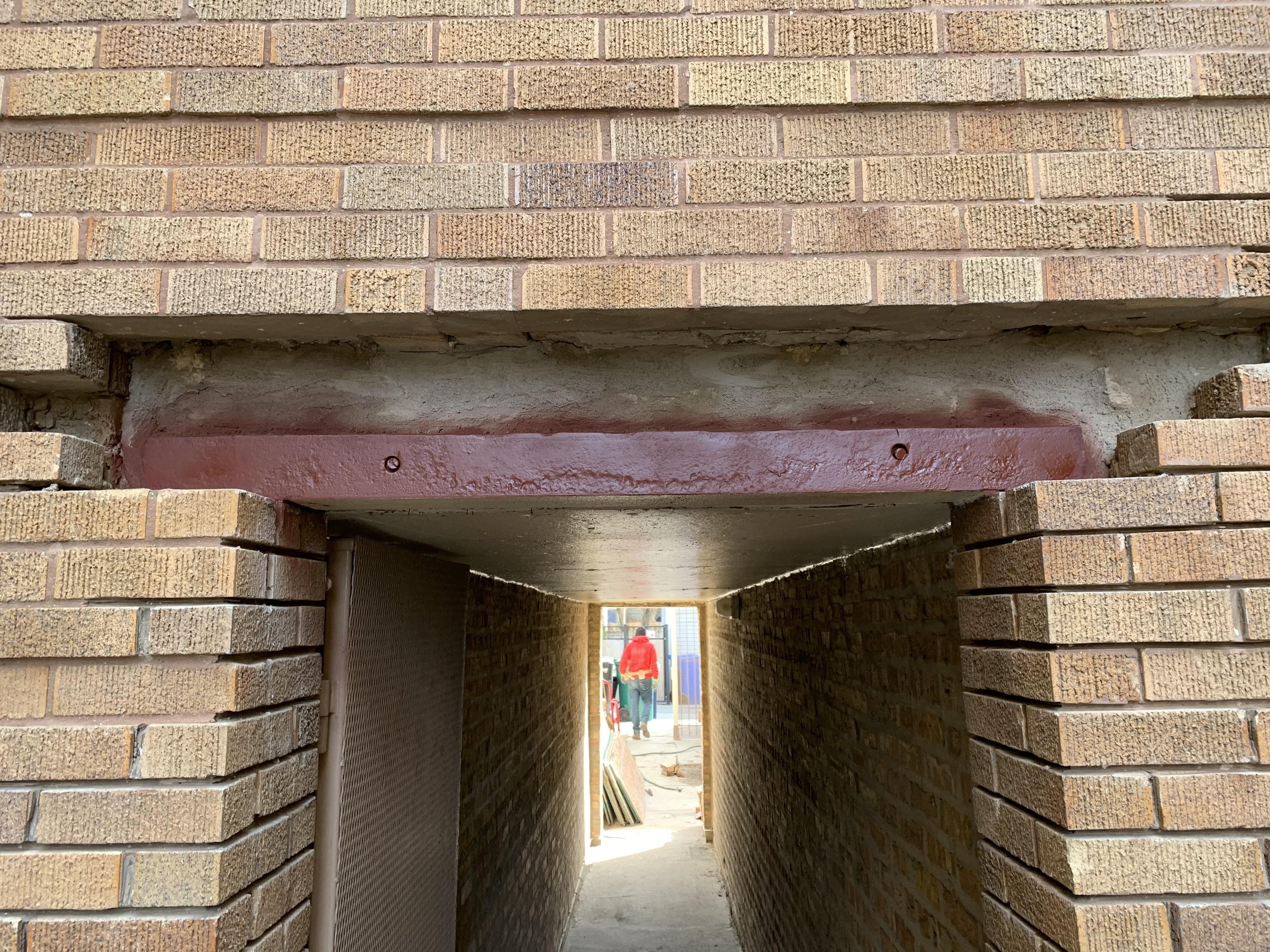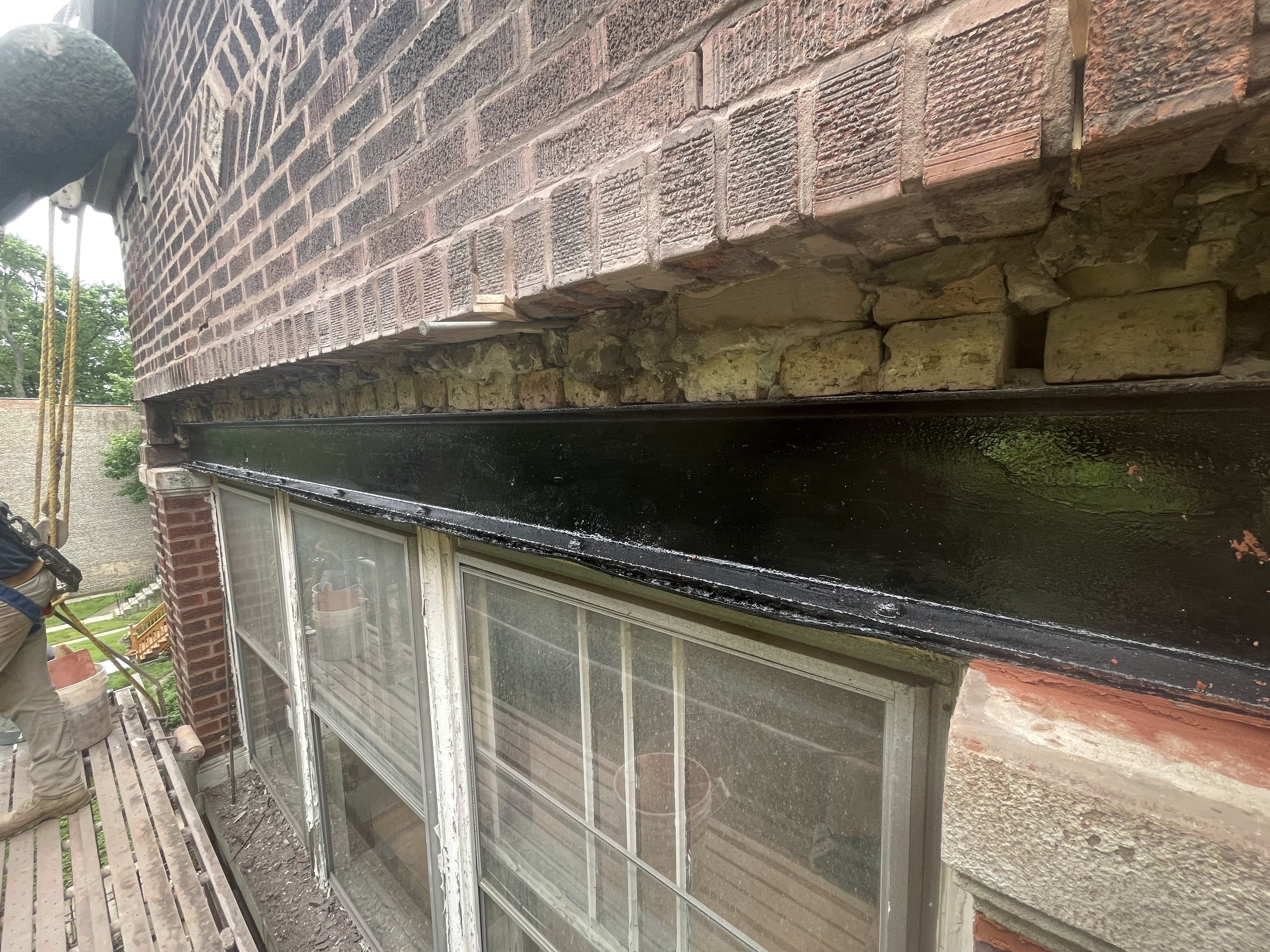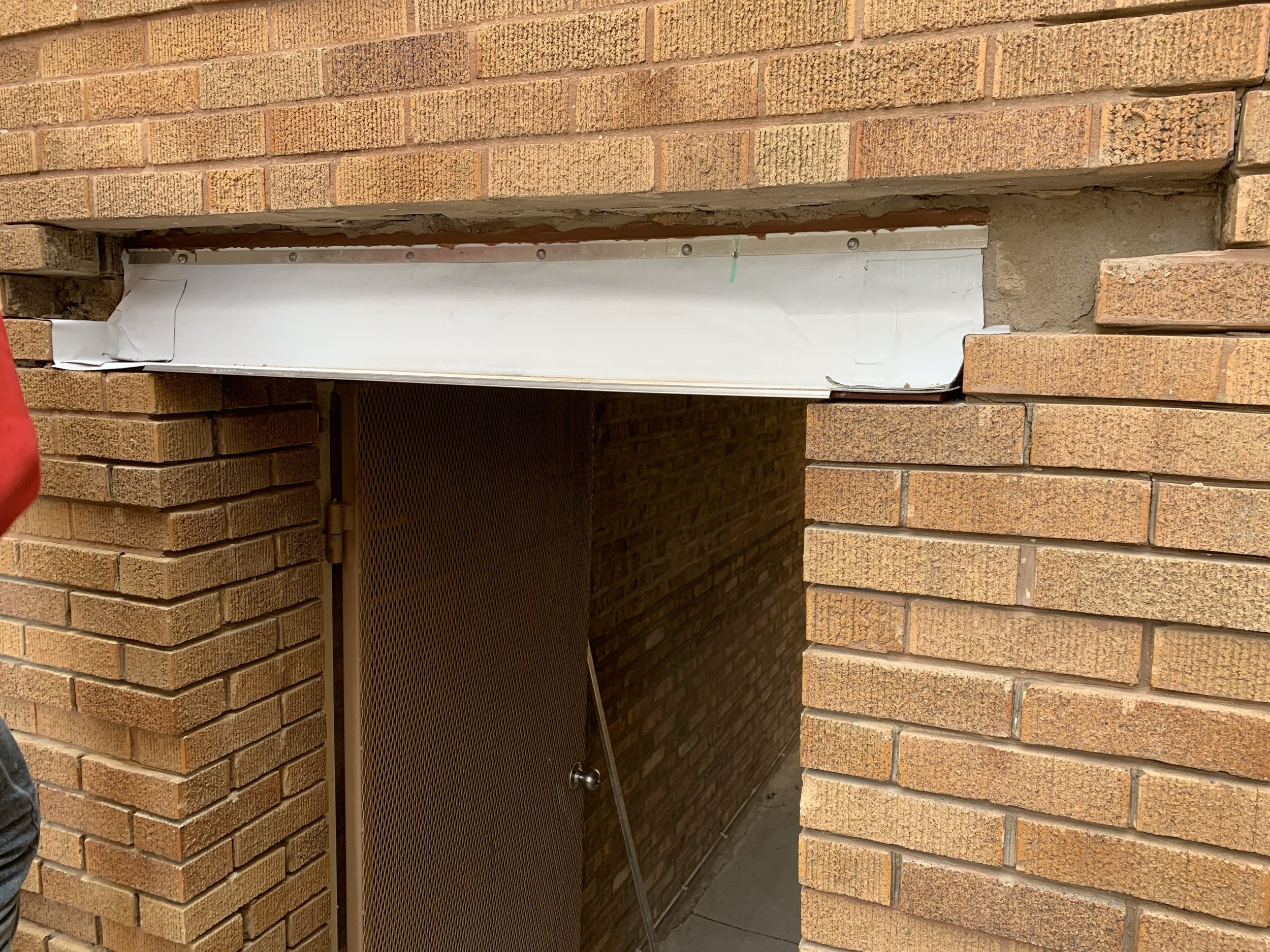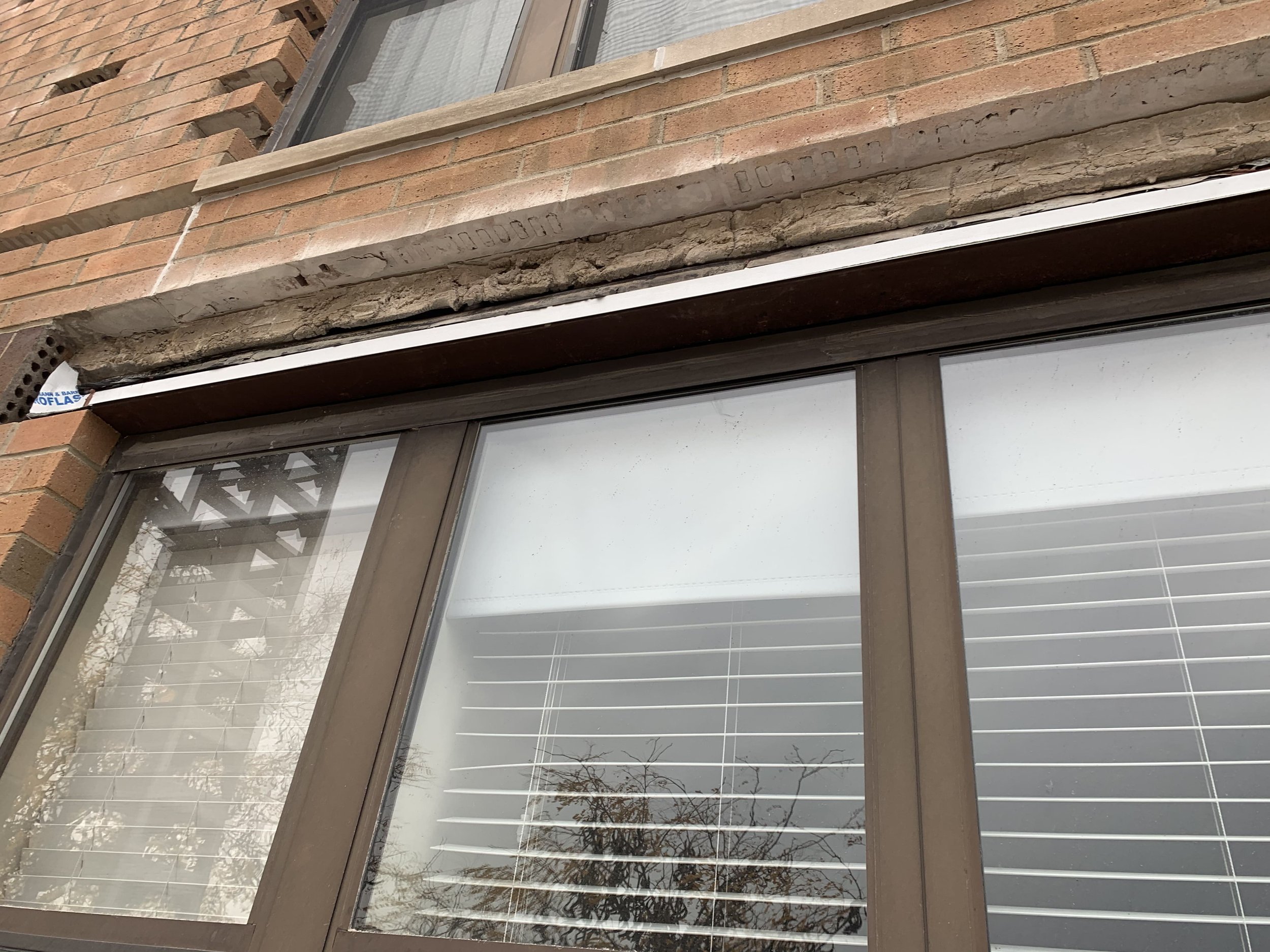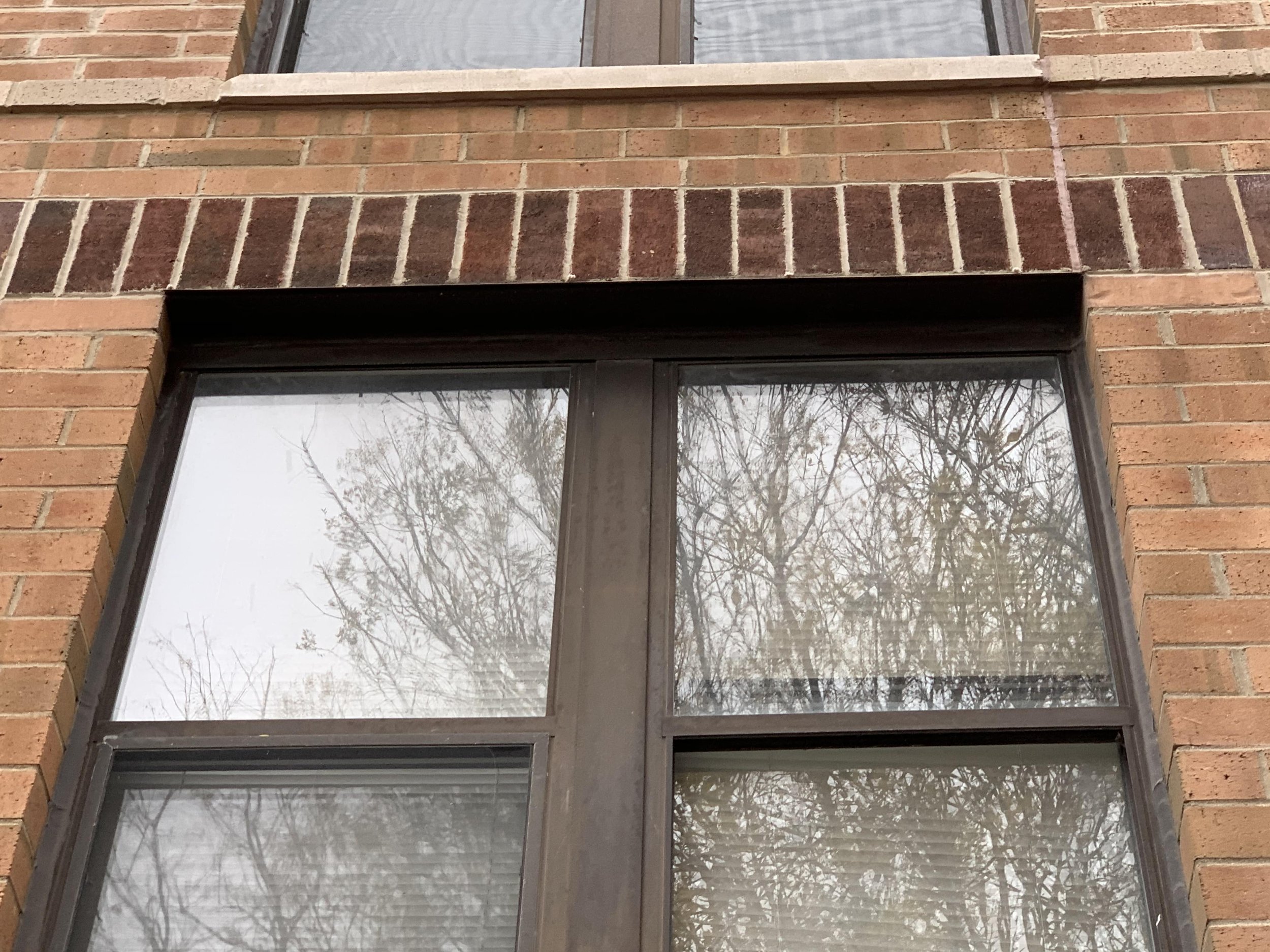
Steel lintel replacement in Chicago
Lintel replacement in Chicago is an essential service for maintaining the structural masonry and aesthetics of a building. At Krisbud Construction, we’ve replaced thousands of lintel beams and specialize in high-quality lintel replacement and i-beam repair services. With years of experience and a strong understanding of masonry restoration, we are your trusted experts for lintel replacement to keep your building safe and looking good.
What is a lintel?
A lintel is a steel beam that spans above various openings in a building, such as windows openings, doors, entryways, etc. The main purpose of a steel lintel is to support the structure above it, as windows and doors themselves cannot sustain that load properly. Lintels can also be used for decorative purposes in certain buildings.
To ensure the structural stability of the building, load-bearing lintels need to be replaced when they are damaged, corroded, and causing problems to the surrounding masonry. When lintels are corroded or rusted due to water penetration, they will expand, which creates pressure and leads to cracks, displacement, and other damage to the surrounding brickwork and mortar joints. As a result, lintel replacement in Chicago often involves rebuilding parts of the surrounding wall that have been damaged due to the bad lintel. The longer a damaged lintel is not fixed, the worse it will become and the more damage it will cause to the building’s masonry, resulting in a much more costly repair.
Types of Lintels
There are different types of lintels made of various materials depending on the structure. The most common lintels seen in residential, commercial, and industrial buildings in Chicago are steel lintel beams. These beams vary in size and can be anywhere from 2’ to 12’+ depending on the size of the opening that the lintel supports. There are also concrete lintels, stone lintels, timber lintels, curved lintels, and brick lintels. I-beams are also used for larger buildings and openings, as they provide much stronger support than a regular steel lintel beam. Lintels will also vary with the masonry material being supported above it. There can be brick, terracotta, decorative stone, etc…
Signs that a lintel needs to be replaced
Over time, lintels and i-beams swell up and expand due to water penetration, corrosion, and rust, causing a lot of pressure on the masonry wall. Several common signs show when a lintel is in poor condition and needs to be replaced. These include:
Mortar cracks at corners of windows, doors, or openings, as well as sagging above the opening: Simpler lintel replacement with less surrounding repair necessary.
Line cracks in the mortar or surrounding parts of the wall are displaced: Indicative of more severe damage calling for a bigger rebuild.
Broken, protruding bricks, and spalling bricks or stone surrounding the lintel
Falling pieces of mortar from nearby joints
Water leakage and rust stains
Difficulty opening and closing windows or doors
Homeowners or inexperienced masonry contractors may believe that these noticeable problems only call for repairing the bricks and masonry around the lintel, without realizing that the failing lintel is causing these problems to the surrounding masonry and that the steel lintel needs to be replaced to fix the core issue. At Krisbud Construction, we determine the root cause of brickwork problems to propose a solution that will fix the building's masonry for years to come.
Give us a call or click contact us immediately if you notice any of these common problems in your building's exterior.
How is a lintel replaced?
The first step to replacing a lintel is to conduct a thorough inspection of the lintel beam and surrounding brickwork. In certain cases, particularly with larger buildings and i-beam repairs, a structural engineer and architectural drawings will be required to do the job. Once inspected, we determine the size and thickness of the lintel, along with other materials that will be required.
Process of Replacing a Steel Lintel
Remove bricks and stones above opening
Remove the old steel lintel
Insert new lintel and apply rust prevention
4.Install flashing system
5.Install aluminum drip edge
6. Insert weep holes
7. Replace the removed or damaged brick section above and surrounding the lintel
8. Properly clean up the job site where work was performed.
What is the benefit of replacing lintels in the Chicagoland area?
Professional lintel replacement offers several key benefits:
Safety: Most importantly, repairing damaged lintels will ensure that nearby pedestrians and tenants of the building are safe. Damaged lintels can even cause surrounding bricks to fall from a building and cause structural movement to a building, which can pose a severe risk.
Improved Aesthetic Appeal: Lintels in poor condition make a building look worse. Restoring the rusted lintels, along with the adjacent brick damage and cracks will make the building look well-kept and in good shape.
Enhanced Structural Integrity: Strengthens the structure and masonry of your building.
Prevention of Further Damage and Cost Savings: Addressing issues before they become more serious and result in more work will prevent costly repairs in the future. More rain, snow, and other weather conditions will cause more water damage to the already bad lintel, leading to more structural damage in the brick wall around the lintel. We’ve seen property owners avoid repairing lintels for one year, only for the lintel to cause damage and structural shifts to the parapet wall above over the next 5 years, resulting in a job 5 times as big as the original job that was only replacing lintels.
Increased Property Value: Well-maintained brick buildings and other masonry structures, especially with quality masonry work, have higher market values.
Prevent masonry building code violations in Chicago: Not maintaining a building's masonry and steel lintels can result in a code violation from Chicago or other local cities. This can be costly, time-consuming, and stressful to resolve when it could be prevented ahead of time.
What causes lintel damage in the greater Chicago area?
Lintel damage can be caused by various factors, including:
Harsh Weather Conditions: Chicago's weather can cause significant wear on lintels.
Freeze-Thaw Cycles: Repeated freezing and thawing can weaken materials.
Moisture and Rust: Water infiltration leads to rust in steel lintels and deterioration of other materials. An inexperienced masonry contractor can add to this problem by improperly restoring the brickwork and lintel, making it so that the bricks cannot “breathe”, resulting in trapped moisture.
Poor Construction: Low-quality materials or techniques can result in premature lintel failure.
Frequently Asked Questions (FAQs) About Lintel Replacement
How long does the lintel installation take?
Replacing a single lintel can be done in less than a day at the simplest level. For more serious projects, where many large lintels need to be replaced, the surrounding brickwork has to be restored, and the lintels are above the ground floor then the project length can last up to many weeks.
What is the cost of lintel replacement? How much is it to replace a lintel in Chicago?
The cost of lintel replacement in Chicago depends on several factors but typically ranges from $220-$600 per linear foot. However, this does not include the costs of permits, scaffolding, protection setup, and additional masonry services required due to the damage surrounding the lintel. When determining a price to replace a lintel, we must also consider the type of lintel and the surrounding masonry materials if they need to be replaced. Certain buildings will contain decorative and expensive stones above the lintels that need to be restored, or even special order curved lintels. The total costs of lintel replacement projects can thus range dramatically.
How do I know if my lintel needs replacing?
What starts as a crack in the surrounding masonry can lead to complete structural shifts and movement within the building, which poses a threat of even building collapse. Please refer to the above signs that a lintel is in poor condition. As always, it is best to get a professional to inspect and provide information on the condition of your building's masonry and lintel beams.
How long should a lintel last?
A steel lintel can last for a very long time if properly installed with high-quality materials including flashing and drip edge. The lifespan of a lintel depends on multiple factors, such as the quality of the materials used and installation by the contractor, the amount of load the lintel has to support, the overall condition of the building, and the exposure to weather conditions.
Do you need permission to replace a lintel?
It is necessary to always work with the local municipal building and construction departments to obtain the required permits for lintel replacement and masonry restoration services in the greater Chicago area.
Can I replace a lintel myself?
We strongly advise against replacing a lintel yourself. Lintel replacement in Chicago buildings requires an expert analysis to determine the severity of the lintel condition, which lintels need to be replaced, and the condition of the surrounding brickwork. Moreover, removing old lintels and installing new ones can be dangerous and require a skilled Chicago masonry contractor to do the job.
Do you replace lintels on commercial and industrial buildings?
Yes, we replace lintels on residential, commercial, and industrial buildings of all sizes in Chicago. Lintels are equally important to maintain across these different building types. For example, an apartment building will have many window lintels and door openings with lintels that need to be upheld.
Krisbud Construction Chicagoland Lintel Replacement Services
Lintel replacement in Chicago is essential for maintaining the structural integrity and aesthetic appeal of your building. At Krisbud Construction, we are committed to providing high-quality lintel replacement services in Chicago. Contact us today for a free estimate for all your masonry needs in Chicago and the surrounding suburbs.
Contact krisbud Construction
For expert masonry restoration and repair services, contact us today at (312) 725-4075 for more information and to talk to one of our experts. To tell us about your project and book a free, no obligation quote, fill out a form below by clicking book now.
Trusted Lintel Beam Replacement Contractors
Take a look below at more examples of steel lintel beam replacement by our professional contractors.
